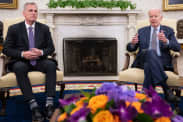The longer the debt-ceiling debate goes unresolved, the more pressure that risks building in credit markets.
“Congress and President Biden have only a handful of scheduled days in session to come to an agreement to raise or suspend the debt limit,” CreditSights analysts led by global head of strategy Winnie Cisar said in a note Tuesday. President Biden met with lawmakers on Tuesday to discuss the debt ceiling.
The U.S. is nearing the so-called X-date, when the country risks defaulting on its obligations if Congress fails to lift its borrowing limit. The X-date is currently presumed to be June 1.
To help guide investors, CreditSights examined the performance of corporate bonds around the debt-ceiling showdown in 2011.
See also: What happens to the dollar if U.S. debt ceiling isn’t raised?
“While the U.S. has gone through many rounds of debt-ceiling roulette in the past decade, 2011 marked a particularly contentious battle in which Congress allowed extraordinary measures to be used right up until the day Treasury thought it could run out of cash leaving it unable to pay its obligations,” the analysts said.
High-yield bond spreads are “the most susceptible” to debt-ceiling-related pressure, they said, estimating that spreads on junk bonds rated CCC are at risk of widening toward 1,500 basis points, as they did in September 2011. Bonds rated below BBB by S&P are below investment-grade.
Investors watch credit spreads as they’re a sign of risk appetite. Credit spreads tend to widen in jittery markets as investors demand more compensation for the risk they’re taking in corporate bonds.
Investment-grade spreads may fare “somewhat better,” particularly for bonds that are higher up the credit-rating spectrum, the CreditSights analysts said.
The chart below shows the amount of movement in basis points for high-yield-bond spreads in the months and weeks before the 2011 debt-ceiling resolution versus so far in 2023, including based on the debt’s ratings and maturities.

“At the ratings level, we find that CCCs fared the worst in both 2011 and over the past three months, followed by Bs and BBs, which have both performed better recently than in 2011,” the analysts said. “Even as CCCs have underperformed recently, the amount of spread widening is roughly two-thirds of 2011 levels.”
Bonds rated CCC have seen spreads widen 101 basis points in the past three months, compared with 157 basis points in the three months before the 2011 debt-ceiling resolution, the chart shows. “However, we note that the starting point for CCC spreads was materially tighter in May 2011,” the analysts said.
Also read: Biden jokes about solving ‘all the world’s problems’ at start of debt-ceiling meeting with lawmakers
In 2011, the macroeconomic backdrop was also challenging, with the U.S. still recovering from the global financial crisis while Europe was grappling with weakness in its banking system and a sovereign debt crisis, according to the report.
But “unlike today, monetary policy was extremely loose across the globe,” the analysts said. The Fed has aggressively tightened monetary policy in the past year to fight stubbornly high inflation.
Meanwhile, high-yield bond spreads in the U.S. widened 27 basis points last week to 477 basis points over comparable Treasurys on May 5, a separate report Tuesday from CreditSights shows.
Junk bond ETFs are up so far this year.
The SPDR Bloomberg High Yield Bond ETF
JNK,
See also: U.S. could run out of cash as soon as early June, think tank says







